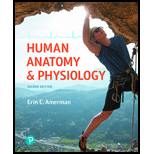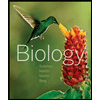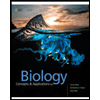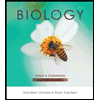
EP HUMAN ANATOMY+PHYSIOLOGY-MOD.MASTER.
2nd Edition
ISBN: 9780134788067
Author: AMERMAN
Publisher: PEARSON CO
expand_more
expand_more
format_list_bulleted
Concept explainers
Question
Chapter 23.3, Problem 4QC
Summary Introduction
To review:
The fate of the carbon skeletons of amino acids.
Introduction:
The proteins in the diet are catabolized in order to perform oxidative catabolism. It also maintains amino acid levels in the blood and helps in amino acid anabolism. The catabolism of amino acids is done in hepatocytes.
Expert Solution & Answer
Want to see the full answer?
Check out a sample textbook solution
Students have asked these similar questions
For each response, you must first state whether you are accepting or rejecting that statement. Then,you must write a detailed explanation why you accept or reject each of the choices.PROBLEM:
After playing beach volleyball on a hot summer day, Sam is sweating hard and feeling very thirsty. Afriend suggests drinking some beer to help his body replace the fluids it has lost. Which one of thefollowing statements contains the most logical and accurate response?A. Great idea! In addition to the fluid, the beer will replenish nutrients he's used up.B. Good idea! Not only will the beer replenish the fluids, but it will help remove excess salts that haveaccumulated.C. No way! Although the beer will replenish the fluids, it will cause removal of important solutes fromthe kidneys.D. No way! The beer will only intensify the problem of dehydration by suppressing ADH.E. No way! The beer may help replenish the fluids, but it will merely make him sweat even more
For each response, you must first state whether you are accepting or rejecting that statement. Then,you must write a detailed explanation why you accept or reject each of the choices.PROBLEM:
After playing beach volleyball on a hot summer day, Sam is sweating hard and feeling very thirsty. Afriend suggests drinking some beer to help his body replace the fluids it has lost. Which one of thefollowing statements contains the most logical and accurate response?
D. No way! The beer will only intensify the problem of dehydration by suppressing ADH.
This practice question is from the textbook "Genetics: From Genes to Genomes". It is chapter 13, question 9.
a. Which two of the breakpoints could yield a deletion?
b. Write the sequence and polarity of a 16-base primer that, in conjunction with primer A, will allow you to diagnose the presence of a deletion in a patient’s genomic DNA. The evidence should be positive, not negative. (That is, you will see a PCR product whose presence and/or size is specific to the deletion; the absence of a band is not informative.)
c. Which two of the breakpoints could yield an inversion?
d. Write the sequence and polarity of a 16-base primer that, in conjunction with primer A, will allow you to diagnose the presence of an inversion in a patient’s genomic DNA. Your answer should show the primer that would yield the longest possible diagnostic PCR product. Your primer cannot cross any of the red lines.
e. Which two of the breakpoints could yield a reciprocal translocation? (Two possible answers exist;…
Chapter 23 Solutions
EP HUMAN ANATOMY+PHYSIOLOGY-MOD.MASTER.
Ch. 23.1 - 1. How do catabolism and anabolism differ?
Ch. 23.1 - Prob. 2QCCh. 23.1 - 3. How do endergonic and exergonic reactions...Ch. 23.1 - Why are endergonic and exergonic reactions...Ch. 23.1 - Prob. 5QCCh. 23.1 - How does ATP fuel cellular processes?Ch. 23.1 - 7. In an oxidation-reduction reaction, what...Ch. 23.1 - 8. What is electron affinity? Do electrons flow...Ch. 23.1 - What is the electromotive force?Ch. 23.2 - How do substrate-level phosphorylation and...
Ch. 23.2 - What is glycolytic catabolism? Why is it also...Ch. 23.2 - Prob. 3QCCh. 23.2 - Prob. 4QCCh. 23.2 - Prob. 5QCCh. 23.2 - 6. Why is it important to regenerate NAD+ under...Ch. 23.2 - 7. What products are generated by the citric acid...Ch. 23.2 - Prob. 8QCCh. 23.2 - What is the potential energy in the bonds of...Ch. 23.3 - Prob. 1QCCh. 23.3 - Prob. 2QCCh. 23.3 - Prob. 3QCCh. 23.3 - Prob. 4QCCh. 23.3 - Why must the body eliminate the ammonia that...Ch. 23.4 - 1. How is glucose stored in the body?
Ch. 23.4 - Prob. 2QCCh. 23.4 - Prob. 3QCCh. 23.4 - Prob. 4QCCh. 23.4 - How are nonlipids converted into fats?Ch. 23.4 - Prob. 6QCCh. 23.4 - Prob. 7QCCh. 23.5 - 1. Why does anabolism dominate in the absorptive...Ch. 23.5 - Prob. 2QCCh. 23.5 - Prob. 3QCCh. 23.5 - Prob. 4QCCh. 23.5 - Prob. 5QCCh. 23.5 - 6. How do the actions of leptin differ from those...Ch. 23.6 - Prob. 1QCCh. 23.6 - Prob. 2QCCh. 23.6 - Prob. 3QCCh. 23.6 - Prob. 4QCCh. 23.6 - Prob. 5QCCh. 23.6 - Prob. 6QCCh. 23.6 - Prob. 7QCCh. 23.6 - Prob. 8QCCh. 23.7 - Prob. 1QCCh. 23.7 - Prob. 2QCCh. 23.7 - Prob. 3QCCh. 23.7 - Prob. 4QCCh. 23.7 - Prob. 5QCCh. 23.7 - Prob. 6QCCh. 23.7 - Prob. 7QCCh. 23.7 - Why is HDL considered good cholesterol, whereas...Ch. 23.7 - Prob. 9QCCh. 23.7 - Prob. 10QCCh. 23.7 - Prob. 11QCCh. 23 - Which of the following statements is false? a....Ch. 23 - Prob. 2CYRCh. 23 - Fill in the blanks: A/an ________reaction releases...Ch. 23 - Mark the following statements as true or false. If...Ch. 23 - Prob. 5CYRCh. 23 - Place the following events of glucose catabolism...Ch. 23 - Which of the following statements is false? a....Ch. 23 - Prob. 8CYRCh. 23 - Prob. 9CYRCh. 23 - Prob. 10CYRCh. 23 - Prob. 11CYRCh. 23 - Prob. 12CYRCh. 23 - Prob. 13CYRCh. 23 - Prob. 14CYRCh. 23 - Prob. 15CYRCh. 23 - Prob. 16CYRCh. 23 - Prob. 17CYRCh. 23 - Prob. 18CYRCh. 23 - Prob. 19CYRCh. 23 - 20. Which of the following statements is false?
a....Ch. 23 - Prob. 21CYRCh. 23 - Prob. 22CYRCh. 23 - Prob. 1CYUCh. 23 - Prob. 2CYUCh. 23 - Prob. 3CYUCh. 23 - Prob. 4CYUCh. 23 - People with extremely restricted caloric intake...Ch. 23 - Prob. 1AYKACh. 23 - Prob. 2AYKACh. 23 - 3. Certain dietary supplements for weight loss...Ch. 23 - Prob. 4AYKBCh. 23 - Prob. 5AYKB
Knowledge Booster
Learn more about
Need a deep-dive on the concept behind this application? Look no further. Learn more about this topic, biology and related others by exploring similar questions and additional content below.Similar questions
- MyoD is a transcriptional factor that acts specifically in muscle cells. It is hypothesized that Id proteins indirectly repress the transcription of muscle-specific proteins by inhibiting the function of MyoD. Which of the following are mechanisms by which Id proteins act as indirect repressors? (choose all that applies) Compete with activators for access to an enhancer. Bind the activation domain of an activator bound to an enhancer. Bind to activators and hold them in the cytoplasm. Form heterodimers with activators and lessen the homodimers of activators. Please explain each answer choice please.arrow_forwardWeek 4 Rodney Balbo's Imaging servicearrow_forward"Which of the following about transposable elements (TEs) is false?" RNA transposons move using an RNA intermediate. DNA transposons make up 3% of the human genome but are disruptive. Genes can move within the same chromosome via TEs. The Drosophila P element can only move in germline cells. Can you explain each answer choices pleae?arrow_forward
- What will control the rate of bioremediation of petroleum? (Choose all correct answers) The availability of the petroleum The temperature of the water The availability of oxygen The percent of the population that has degraded petroleum in the pastarrow_forwardWhich of the following would lead to a false negative result in a sandwich ELISA (the lab manual refers to this as a direct ELISA- also known as search for antigen)? Mark all correct answers. antibody was non-specific and bound to something other than the antigen of interest. too short of a duration when incubating the reagents in the plate. If there are multiple strains of the pathogen of interest and the antibody does not recognize one of the strains. Did not sample the correct bodily fluid/area to detect the antigen concentration of antigen was too low to detect in the patient sample. inadequate washing was performed after the enzyme linked antibody was allowed to bind. substrate was exposed to too much light reusing a pipette that was used to pipette a positive sample.arrow_forwardS. +1269 pts /1500 © Macmillan Learning 0 Resources Solution Penalized Feedback Try Again Draw the final product with stereochemistry and lone pairs. The leaving group has been pre-drawn for your convenience. +100 +100 : 0: + H,C- :0: : 0 0 : +100 +94 possible ✓ +100 K Attemparrow_forward
- +1269 pts /1500 © Macmillan Learning t/1188d950-dd73-11e0-9572-0800200c9a66/3045511b-267e-4a00-86ca-85dbc62ecb4e/6ac3a0c9-... a □ 出 All Bookmarks Due: Mon, May 26 Resources Solution Penalized Feedback Try Again KX Attempt 3 Draw the final product with stereochemistry and lone pairs. The leaving group has been pre-drawn for your convenience. :0: + нс H,C- :0: : 0:arrow_forwards. +1169 pts /1500 © Macmillan Learning 0 Resources Hint Submit Answer Step 3: This tertiary carbocation intermediate readily undergoes elimination with any weak base to form two possible products. + + H :0: H +94 possible 3a) Draw the minor organic product of elimination. Select Draw Templates More +100 +95 possible # C Major product + Minor product 3b) Draw the major organic product of elimination. Erase Select Draw Templates More C Erasearrow_forwardExplain the Science & Society on (with links and pictures): ---- Question down below Discuss the ethical, medical, and societal implications of using advanced genetic techniques?arrow_forward
- Explain the Disease Mechanism & Impact on (with links and pictures): What causes Leigh Syndrome and why it's so deadly. Which cellular functions, organelles (especially mitochondria), and macromolecules are involved.arrow_forwardExplain the Disease Mechanism & Impact on (with links and pictures): What's going wrong inside the cell and the effects on the human body. Describe metabolism with an emphasis on cellular respiration.arrow_forwardExplain the Disease Mechanism & Impact on (with links and pictures):arrow_forward
arrow_back_ios
SEE MORE QUESTIONS
arrow_forward_ios
Recommended textbooks for you
 Biology (MindTap Course List)BiologyISBN:9781337392938Author:Eldra Solomon, Charles Martin, Diana W. Martin, Linda R. BergPublisher:Cengage Learning
Biology (MindTap Course List)BiologyISBN:9781337392938Author:Eldra Solomon, Charles Martin, Diana W. Martin, Linda R. BergPublisher:Cengage Learning Human Biology (MindTap Course List)BiologyISBN:9781305112100Author:Cecie Starr, Beverly McMillanPublisher:Cengage Learning
Human Biology (MindTap Course List)BiologyISBN:9781305112100Author:Cecie Starr, Beverly McMillanPublisher:Cengage Learning
 Human Heredity: Principles and Issues (MindTap Co...BiologyISBN:9781305251052Author:Michael CummingsPublisher:Cengage Learning
Human Heredity: Principles and Issues (MindTap Co...BiologyISBN:9781305251052Author:Michael CummingsPublisher:Cengage Learning Biology Today and Tomorrow without Physiology (Mi...BiologyISBN:9781305117396Author:Cecie Starr, Christine Evers, Lisa StarrPublisher:Cengage Learning
Biology Today and Tomorrow without Physiology (Mi...BiologyISBN:9781305117396Author:Cecie Starr, Christine Evers, Lisa StarrPublisher:Cengage Learning

Biology (MindTap Course List)
Biology
ISBN:9781337392938
Author:Eldra Solomon, Charles Martin, Diana W. Martin, Linda R. Berg
Publisher:Cengage Learning

Human Biology (MindTap Course List)
Biology
ISBN:9781305112100
Author:Cecie Starr, Beverly McMillan
Publisher:Cengage Learning



Human Heredity: Principles and Issues (MindTap Co...
Biology
ISBN:9781305251052
Author:Michael Cummings
Publisher:Cengage Learning

Biology Today and Tomorrow without Physiology (Mi...
Biology
ISBN:9781305117396
Author:Cecie Starr, Christine Evers, Lisa Starr
Publisher:Cengage Learning
Macromolecules | Classes and Functions; Author: 2 Minute Classroom;https://www.youtube.com/watch?v=V5hhrDFo8Vk;License: Standard youtube license